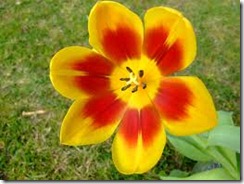Tulips are elegant, simple, six-petaled flowers with rounded, egg-shaped buds. Modern tulips are descended from the tulip-mania period in Holland in the mid-1600s. Tulips are early flowering bulb plants that multiply and return year after year. For the brief time they are in bloom in early spring, tulips provide a bright splash of color after winter and before the rest of the landscape has completed greening and blooming. Once tulips have bloomed, they are finished until next spring but still need some attention.
Tulip Care When Growing
-
When the first green tulip sprouts appear in the spring, begin fertilizing them with a manure tea solution or a flowering plant fertilizer higher in phosphorus than nitrogen to support bud set and flowering. After flowers have opened, continue fertilizing with manure or compost tea or a fertilizer higher in nitrogen while the leaves are still green. Do not cut leaves when green because they need to continue photosynthesis to prepare the bulbs for next year’s blooms. Only cut tulip leaves after they have browned and wilted.
Tulip Care After Leaves Have Died
-
After tulips have finished blooming and the leaves have turned brown and wilted, cut back leaves and stems and remove them for composting or disposal. Stop watering and let the soil dry, unless you plan to grow other flowers in the same bed. If the tulips were crowded, dig up every second or third bulb to remove from the bed and plant elsewhere, give away or discard.
How to Use Tulips in the Garden
-
Plant tulip bulbs en masse in flower beds in full sun in front of front porches, along driveways or along fences. Use them to introduce color in the spring before everything else has started blooming, or plant tulips among other early-blooming spring plants such as forsythia, hyacinths and daffodils for a bright spring display. Tulips are easy plants for container gardening as well, to decorate patios or front entryways.
Tulip Life Cycle
-
Beautiful tulip flowers begin as bulbs resembling tear drop-shaped onions. They are planted pointed tip-up a couple of inches deep, the deeper the better to discourage hungry squirrels and rodents from digging them up to eat. With water and soil temperature changes in the spring, the bulb swells and sends out roots from its base and the stem at its top begins to grow up through the soil. Two straight green leaves surrounding a central stalk poke through the soil, gradually unfolding into two large leaves and stiff stalk, which produces a bud. A few more leaves grow, the stem thickens and the bud enlarges. Buds open after a few days, lasting one to two days depending on wind and rain conditions. Petals loosen and drop off, leaving the central stalk bare. Leaves remain green for a week or longer after flowers are gone, then die back.


Deprecated: strpos(): Passing null to parameter #1 ($haystack) of type string is deprecated in /home/agriviek8Qv/agriviet.net/public_html/wp-includes/comment-template.php on line 2522